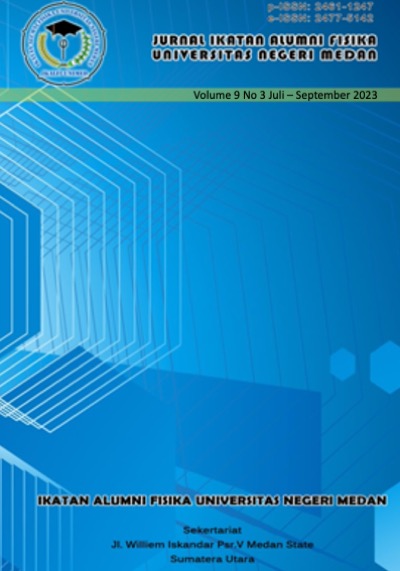Optimasi Efisiensi Tungku Sekam dengan Variasi Lubang Utama pada Badan Kompor
DOI:
https://doi.org/10.24114/jiaf.v9i3.48625Keywords:
Fuel, Efficiency, Husk, FurnaceAbstract
Energy sources are classified into two, namely renewable energy sources and non-renewable energy sources. Most people currently use non-renewable fuels for industrial, transportation and household needs. Whereas the availability of these fuels is decreasing over time so that the economic value is getting higher and more difficult to reach. Of the three fuel user sectors, it is the household sector that feels the impact of fuel scarcity and price increases the most. This research is classified as experimental research, which was carried out in the Physics department of FMIPA IPB. The time needed for this research is 4 months including proposal preparation and research. The material used in this study are rice obtained from around the Dramaga sub-district. Zinc (Zn) Iron (Fe) is used to make husk furnaces. Based on the test results, it can be seen that the effective flame is influenced by the air flow in the husk stove which comes from the air trapped in the stove body. If there are additional holes other than the main hole, the possibility of air escaping from the hole so that the trapped air cannot flow optimally to the ventilator. This affects the flame produced, which requires Oâ‚‚ for combustion. Based on the results of analysis and trials, the husk furnace requires maximum airflow to carry out the combustion process. Therefore, the trapped air must be made as much as possible. From the research conducted, it was found that the size that produces high efficiency is type C (core hole of 20 x 9 cm) with an efficiency of 18%.References
Andriati Amir Husin Pemanfaatan Sekam Padi dan Abu Sekam Padi untuk Pembuatan Bata Berlubang. e- jurnal Balitbang PU.Pusat litbang pemukiman. Bandung. 2007.www.pu.go.id/balitbang.
A. T. Belonio. 2005. Rice Husk Gas Stove Handbook. Appropriate Techonology Center. Department of Agricultural Engineering and Environmental Management. College of Agriculture Central Philippine University Iloilo City.
Harsono Heru. Pembuatan Silika Amorf dan Limbah Sekam Padi. Jurnal Ilmu Dasar, 3 No.2, 2002: 98-103. Jurusan Fisika FMIPA Universitas Brawijaya. 2002.
Irzaman, H. Alatas, H.Darmasetiawan, A. Yani dan Musiran. 2008. Development of Cooking Stove from Waste (Rice Husk). Institut Pertanian Bogor, Department of Physics, FMIPA IPB, Kampus IPB Dramaga.
Osmen Gultom. 2000 Pengkajian Recovery Energi Hasil Proses Insenerator Untuk PemanasanUdara Pembakaran Pusat pengembangan Pengelolaan Limbah Radioaktif.
R. Rachmat. 1991. Kompor Sekam Segar. Karawang : BB Litbang Pascapanen.
Thorburn, Craig. 1982. Rice Husk as a Fuel. Bandung: PT Tekton Books: Pusat Pembangunan Institut Teknologi Bandung.
United Nations Environment Programme. Peralatan Energi Panas: Tungku dan Refraktori. Pedoman Efisiensi Energi untuk Industri. 2006 www.energyefficiencyasia.org.
Warta Penelitian dan Pengembangan Pertanian, Giliran Sekam untuk Bahan Bakar Alternatif, 28 (2), 2006.
Downloads
Published
Issue
Section
License
Copyright (c) 2023 JURNAL IKATAN ALUMNI FISIKA

This work is licensed under a Creative Commons Attribution 4.0 International License.
Authors who publish with this journal agree to the following terms:- Authors retain copyright and grant the journal right of first publication with the work simultaneously licensed under a Creative Commons Attribution License that allows others to share the work with an acknowledgement of the work's authorship and initial publication in this journal.
- Authors are able to enter into separate, additional contractual arrangements for the non-exclusive distribution of the journal's published version of the work (e.g., post it to an institutional repository or publish it in a book), with an acknowledgement of its initial publication in this journal.
- Authors are permitted and encouraged to post their work online (e.g., in institutional repositories or on their website) prior to and during the submission process, as it can lead to productive exchanges, as well as earlier and greater citation of published work (See The Effect of Open Access).


 Jl. Williem Iskandar Psr. V, Medan Estate, Kec. Percut Sei Tuan, Kabupaten Deli Serdang, Sumatera Utara 20221
Jl. Williem Iskandar Psr. V, Medan Estate, Kec. Percut Sei Tuan, Kabupaten Deli Serdang, Sumatera Utara 20221